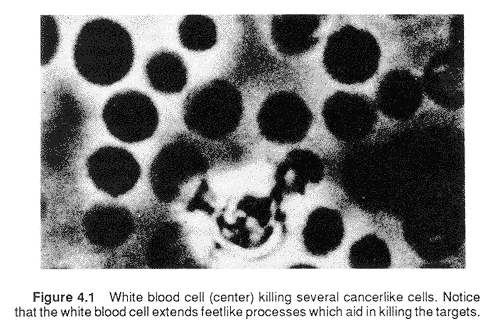Poor populations around the world that suffer from malnutrition are more susceptible to infection than those who receive adequate nutrition. Investigators studying the relationship between the immune system and nutrition have found that nutrition affects immunity (1,2) and also affects the development of cancer (3,4) either directly or indirectly via the immune system.
The immune system is a complex interaction of blood cells, proteins, and processes that protects you from infections, foreign substances, and cancer cells that spontaneously develop in the body.
In 1989, research at the Shriner's Burn Institute in Cincinnati showed that administration of a special liquid diet to severely burned patients begun the day they were burned reduced the risk of infection by 50 percent. The special diet consisted of protein, vitamins including A and E, minerals, and iron, as well as omega-3 fatty acids.
White blood cells and antibodies are two major armies of the immune system. These armies arise separately but are related and dependent upon each other for their development and maturity. The Iymphocyte, a specific type of white blood cell, is the main cell involved in cellular immunity. Lymphocytes make up only a small portion of the blood, comprising only about 15 to 20 percent of all white cells. The Iymphocyte population is divided into two large groups, based on particular markings on the outer surface membrane of the cell.
T Iymphocytes, or T cells, are one group of Iymphocytes. They are derived from or are under the influence of the thymus, which is an organ in the neck and front part of the chest that is functionally active in early childhood. T cells are responsible for your defense against cancer, fungi, certain bacteria (intracellular), some viruses, transplant rejections, and delayed skin reactions (tuberculosis skin test). T cells are further divided into several subpopulations: helper T cells and suppressor T cells, those which either help or hinder normal immune cellular function.
Proteins called antibodies or immunoglobulins are produced by the other major group of Iymphocytes, the B Iymphocytes, or B cells. B cells may have their origin in the bone marrow, from which they derive their designation. Antibodies are formed by the B cell in response to a foreign substance introduced into the body. For example, when a person is given a vaccine against polio, antibodies to this foreign substance are made by the B cells. If the polio virus enters the body in an infectious state after a person has been vaccinated, the previously formed antibody, which is circulating in the blood, will attach to this foreign intruder and dispose of it with the help of defending white blood cells or other proteins called complement proteins or a combination of both. The same process of antibody production is initiated by some cancer cells. Killing white blood cells or complement proteins, when activated by an antibody, destroy a foreign-appearing cell by making holes in the foreign cell's membrane, thereby allowing water to rush in and explode the cell. In 1980, I showed how a white blood cell kills a foreign cancerlike cell Figure 4.1 shows a white blood cell (center) killing several cancerlike cells. Notice that the white blood cell extends feetlike processes that aid in killing the targets. (5)

Phagocytes are another group of white blood cells that reside in the blood and body tissues and are part of your defenses against foreign invaders. These also act as policemen to recognize and dispose of abnormal cancer cells and other foreign substances. Phagocytes can perform this task alone or can recruit antibodies and complement proteins to aid in the disposal.